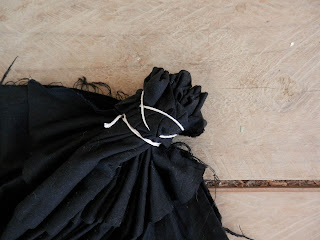So later in the day, my fabric (previously covered in wheat flour resist) was dry. And there I learnt my first lesson. Pin down the edges of your fabric really well. It curls as it dries and if the edges curl too much it's hard to paint.
On my first piece I painted the shapes with runny fabric paint. I had some turquoise Jacquard Dynaflo, which is quite liquid and I added a little black Jacquard textile paint to darken it. I crackled the unpatterned part of the fabric and painted those marks too.
On my next piece I painted household bleach. Uh oh. Nothing happened. This was hand dyed fabric, dyed with procion MX dyes so I just assumed it would dishcharge. But I didn't do what Jane Dunnewold says to do - TEST YOUR FABRIC!
I didn't want to lose my written pattern, so I painted over the bleach with some slightly diluted purple fabric paint. I'm cutting that section off in the above photo because I wanted to wash the plain bleach section off. You need to leave the fabric painted pieces to cure for 24 hours seeing as you can't iron them to heat set them.
I thought the lack of reaction to bleach may have been because my bleach was too old. I have a worm septic system, and worms and bleach don't go well together so I don't use bleach very often. So I folded, tied and dipped some commercial black homespun in the bleach. Nope, my bleach was fine. Instant reaction.
And it ended up a really neat piece of fabric! It's just been rinsed in vinegar water in the pick above. Vinegar neutralises the bleach and then I put it through a rinse cycle in my washing machine.
And here is a closer pic when it's been dried and ironed (ish!).
So here is my first fabric paint piece. Nice crisp patterning with a few crackly bits. The crackle section is interesting too. I was a bit nervous about crackling it too much, but I could have been a bit more vigorous.
You can just see a faint pattern from my bleach discharge. Lesson learnt - test your fabrics.
And here is the writing piece. Nice texture. Doesn't really look like words! I think my paste was a bit goopey and thick. I might try again with a thinner coat of paste and I might try with cornflour paste - less gluey.
For all that effort, I question whether I could have got similar marks from stamping. Probably with the square/circle marks. But I can't get the crackle or the writing texture - unless I want to start playing with batik and wax - so I think it's worth it for those sorts of textures and I'll stick to using it for that.
But fun was had and that's the most important part!










Nice :) I made the mistake of trying water based pva. It made an interesting result but it doesn't come off! I even tried warming it and picking it off - broke a finger nail on that and decided that the raised look was ok anyhow :) Might try the flour next time. Some of the girls used elmers school glue. It does work but they had to google how to get it off. However it does come off at least.
ReplyDeleteI think they tried rice flour and that worked ok. I got too involved with my mono prints to really try that (and I was rather late getting everything ready so didn't have the half of what I really should have had).
Their results are on the other site artfibredunedin.blogspot if you want a look :)
viv
viv
Wow, interesting results - and isn't the bleach one cool! Looks a bit like some of hubby's overalls after he has been working with chemicals at the cowshed! Must remember to dip them in vinegar when he does that!! We used to play with resist, dye etc at Playcentre and I always wondered what it would be like to do it 'properly'! Now I know - and now I am looking forward to seeing what you do next and how you use them :-) No pressure.
ReplyDelete